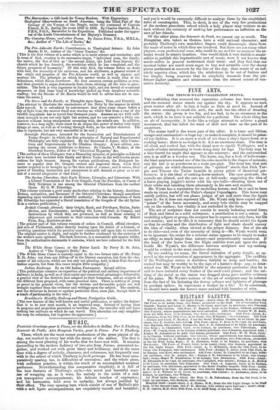FINE ARTS.
THE THENCH-WTATT-WELLENGTON STATUE.
Tim scaffolding that screened the equestrian colossus has been removed, and the monster statue stands out against the sky. It appears no such great matter after all: in fact, it looks as little as need be. Instead of the statue seeming to crush the arch, the arch has the effect of dwarfing the statue: the group is too trig, and too bad, to be an ornament to the arch, which in its turn is not suitable for a pedestal. The whole thing has an air of incongruity; it looks like a vulgar attempt to achieve a grand monument, that has failed for want of skill and taste on the part of its contrivers.
The statue itself is the worst part of the affair. It is tame and lifeless, meagre and mechanical—a huge toy: to make it complete, it should be paint- ed toy-fashion. It is no more a work of art than a ship's figure-head, or a. rocking-horse: there is no design in it: it is an enormous sham. The mania all cloak and cocked hat, with the ducal nose to signify Wellington, and a couple of tubes terminating in boots doing duty for legs. The body may be a beer-barrel for aught that appears to the contrary; and the outstretched arm is as stiff as a wooden one. The horse, too, has a look of hollowness: the hind-quarters remind one of the tin cake-moulds in the shapes of animals; and the tail is as ponderous as a main gas-pipe. The head has that sort of galvanic air which characterizes the "spirited" steeds that Dick Tur- pin and Timour the Tartar bestride in penny prints of theatrical per- formers: it is the ideal of rocking-horse-makers. The eyes protrude, the nostrils are dilated, and the ears are at full-cook; suggesting the idea of a horse playing juggler's tricks with his eye-balls—shooting them out of their orbits and catching them alternately in his ears and uostrils.
Mr. Wyatt has a reputation for modelling horses; and he is said to have
made an exact model of the Duke's charger Co n. This horse may satisfy jockies, but will not please judges of aPrtellnYemore than the figure upon it; for it does not represent life. Mr. Wyatt mat have copied all the "points" of the horse accurately, and every vein visible le may be mapped out on the surface; but vitality is not embodied in the form.
The art of sculpture does not consist in merely imitating actual forms of flesh and blood in a solid substance: a petrifaction is not a statue. In modelling a figure or group, the sculptor has to express not only form, but lifb and motion; and to do this it is necessiuy that he should model the flouts so that its outline and the distribution of light and shade should convey the idea of vitality, when viewed at the proper distance. But of the art to do this—and even of the necessity of doing it—Mr. Wyatt would seem to be ignorant: his recipe for a colossal statue appears to be simply to make an effigy so much larger than nature—and proportionably unnatural. If the head of the horse from the Elgin marbles were put upon the arch beside Mr. Wyatt's, the difference between sculpture and toy-making would be evident to the most careless observer.
By toy-making we mean, the literal imitation of petty details, as op- posed to the representation of appearances in the aggregate. The saddlery of the Wellington statue is doubtless faithful to strap and buckle; the cocked hat may be worthy to be the sign of a hatter's shop: nay, so deter- mined was Mr. Wyatt to be faithful in the minutest particular, that ho is said to have imitated every feather of the cock's-tail plume; and the rat- ding of the metal as the statue was dragged along gave audible evidence of his pains. Mr. Wyatt's notions of the art of sculpture may be inferred from the fitct of his imitating the downy softness and lightness of plumage by pendent spikes: he represents a feather by a file! To be consistent, he should have made the horse's mane and tail with bunches of wire.


























 Previous page
Previous page